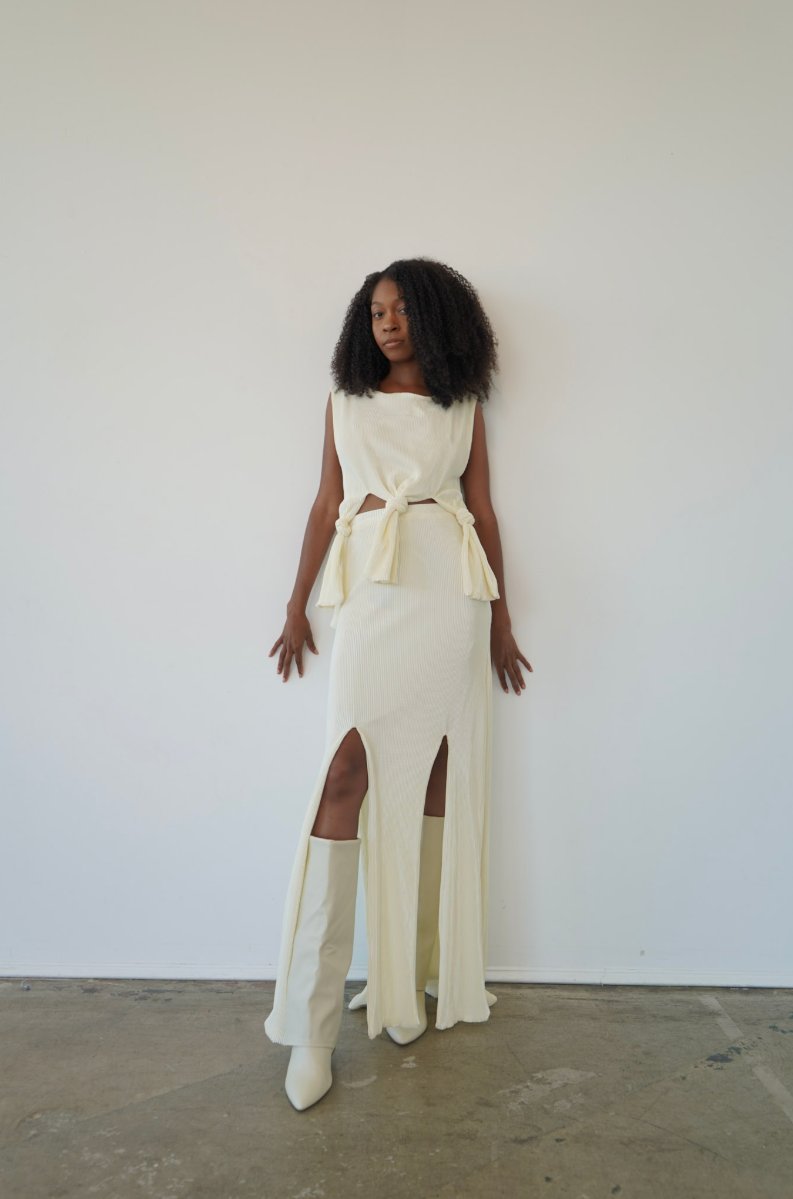THE ORIGINS OF PLEATED PLISSE FABRIC
Share

What Is Pleated Plissé Fabric?
Pleated plissé fabric is a lightweight textile that features permanent, finely pressed pleats or crinkles—giving it a sculpted, wave-like appearance. The word plissé is French for “pleated,” and while it may resemble traditional pleating, the process and purpose are distinct.
Unlike structured pleats that require maintenance, plissé fabric is created through heat-setting (often on polyester) or chemical treatments (commonly on cotton), resulting in a textured, low-maintenance fabric that resists wrinkles and holds its shape beautifully.

Pleated plissé is a study in contrasts: sculptural yet fluid, structured but effortless. Known for its light, rippling texture and resilient structure, it bridges the ancient with the modern. At Keenya Weston, we chose pleated plissé not only for its visual depth but also for its rich legacy in fashion history and its ability to align with our values of timeless, sustainable luxury.
The History of Pleating and Plissé
Pleating techniques date back thousands of years. In Ancient Egypt, pleated linen garments were symbols of status and care, meticulously folded by hand. In Greece, the use of flowing drapes and folds in garments like the chiton influenced fashion silhouettes for centuries to come.
It was in the early 20th century that pleating evolved into a modern design language. Legendary designer Mariano Fortuny patented a process to create ultra-fine, heat-set pleats for his famous Delphos Gown, a fluid silk dress inspired by classical sculpture. The gown, and its revolutionary pleats, needed no corsetry and marked a turning point in luxury women's fashion.
While Fortuny’s pleats were proprietary, the influence of permanent pleating techniques eventually inspired what we now call plissé, making the effect more accessible, versatile, and adapted for contemporary textiles.
How Plissé Fabric Is Made Today
There are two primary methods of producing pleated plissé fabric:
- Heat Set Plissé — Commonly used on synthetic fibers like polyester or poly blends. Fabric is folded or placed between molds, then exposed to heat to create permanent pleats
- Chemical Plissé — Used mostly on cotton or natural blends. A chemical solution, typically caustic soda, is applied selectively to shrink parts of the fabric and create a puckered surface
The result is a lightweight, wrinkle resistant textile that maintains its texture even after washing. Ideal for travel, everyday luxury, and timeless dressing.

Plissé and Sustainability
Beyond aesthetics, plissé fabric supports conscious wardrobe design. Its durability means fewer washes and longer wear, helping reduce textile waste over time. The heat set process on synthetics also reduces the need for steaming or ironing, which helps prolong the life of the garment. It’s a fabric that works harder, lasts longer, and looks refined without effort.
Why We Use Pleated Plissé at KW
For our Robin Set, pleated plissé was a deliberate choice. The fabric’s easy movement, subtle texture, and sculptural finish reflect our values of elegance, functionality, and longevity
Unlike seasonal trends, plissé is built to last. It resists creases, drapes beautifully on every body, and elevates minimalist silhouettes with quiet complexity. Its ability to move with you, not against you, makes it a staple for the modern, purposeful woman.
Explore More
→ Discover the Robin Set — our signature ensemble crafted in pleated plissé fabric for modern movement and lasting elegance.

